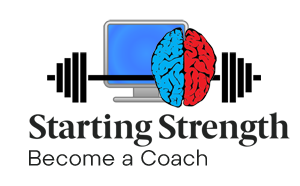Another practical example of the principle of specificity
in the selection of exercises, is the use of the squat
exercise by track and field athletes. This exercise is
very popular for many athletes in sport dominated by
lower body strength and power, however often the
actual depth of the squat is a cause of controversy. The
load used during a full squat tends to be limited by the
force generation capabilities of the body between the
knee angles of approximately 95 to 115 degrees
(McLaughlin et al, 1977). Once through this region,
which is commonly referred to as the ‘sticking region,
the lift is relatively easily completed, in fact towards the
end of the exercise, with approximate knee angles of
140 to 180 degrees, the forces applied by the lifter
against the bar are reduced, as the bar simply coasts to
the final position. However, the force-generating capac-
ity of the body over this range of motion (140 to 180
degrees) is at least one and one half times as great as
that produced at the more flexed position (95 to 115
degrees). Consequently, during the top range of motion
of the full squat the leg and hip extensor musculature
are not overloaded to anything like their full potential.
However, it is during this range of motion (knee angles
of 140 to 180 degrees) that most athletes need to
produce high force levels in their events Consequently
to maximise their training gains, most athletes should
perform a half squat motion, preferably in a power rack,
with substantially more weight than they can use for a
full squat. Therefore, based on the force profiles
involved in the movements, full squats can be
considered non-specific to the leg action of many
athletic events, while half-squats, with substantially
more load than used in full squats, can be considered
to be more specific. As an aside to this discussion on
specificity, it should be noted that the performance of
heavily loaded deep full squats can stretch the cruciate
ligaments of the knee joint making this joint unstable-
Hence their use in training should be fairly limited.










